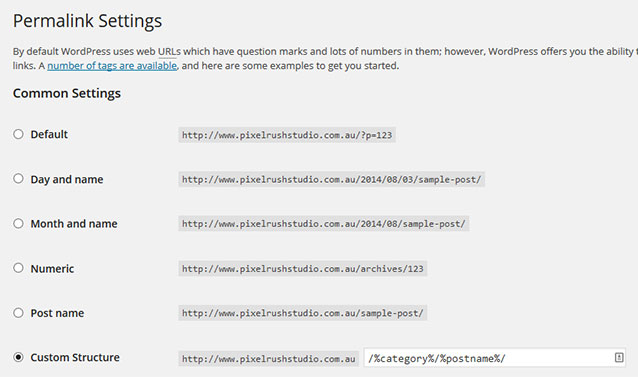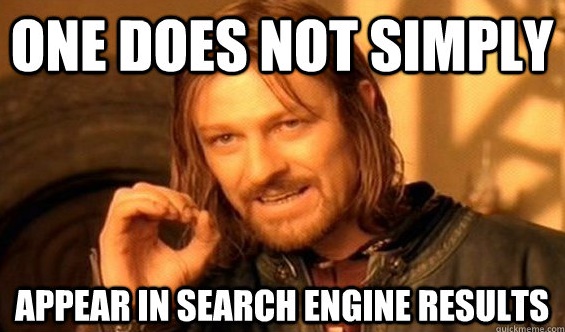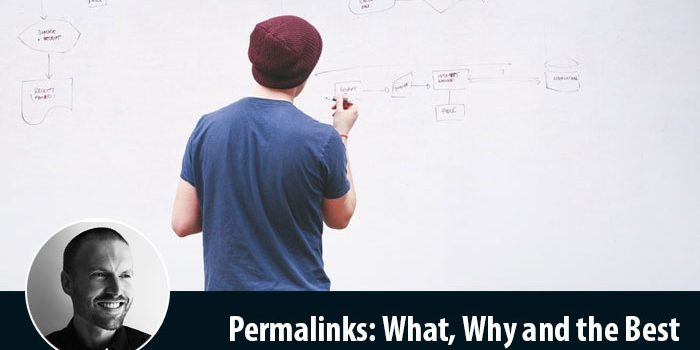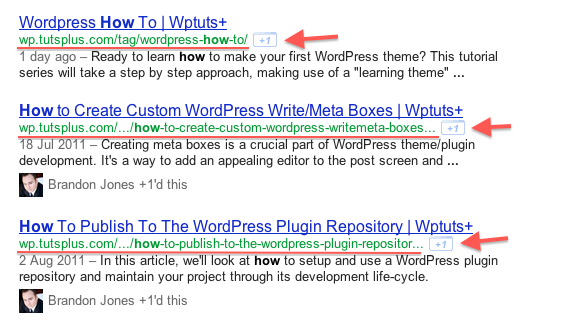So what are Permalinks and why should you use them? Chances are your website might already be using them and you just don’t know it yet. Permalinks are simple in theory, no really they are, because all they are is a permanent link (url) on your website that others can link to your content a.k.a permanent link. Not that scary right?
The concept is simple in theory but it’s easy to get it wrong or simply miss an easy opportunity to improve your SEO. Still confused? Let’s take a look at some examples
- http://example.com/?p=123
- http://example.com/how-to-improve-seo
- http://example.com/wordpress/how-to-improve-seo
- http://example.com/2014/08/03/how-to-improve-seo
Before we go on let me just say that Permalinks are not WordPress specific but because of WordPress popularity it’s best to explain with that in mind.
Why WordPress Fails (on default)
“I blog on a regular basis but I don’t see any traffic to my website”
If this sounds like you then it might be your WordPress Permalink structure as the reason for why you’re not seeing increased traffic. The default installation looks something like this http://example.com/?p=123. On first look you might wonder what is so bad about it? A link is a link right? Wrong. Your link is one of the best ways you can target keywords and achieve improved rankings. Your URL should always include your keywords, just Google something and see for yourself.
Look at the URLs that show up in the results and you’ll find almost all of them use those keywords in their URL.
The reason why WordPress fails is that, by default, it uses unique numbers instead of keywords which has nothing to do with your post at all. What the hell does ?p=123 or any other number mean to you?
How To Change Your Permalink Structure
If you want to change your Permalink structure in WordPress it’s simple but you need to take into consideration how long your content has been available, on your website, and what links are already pointing at it. If your website is day zero then do it now and you can breathe easy that it’s just common sense to make the change. If you’ve been blogging for some time and want to change your permalink structure then you need to ensure that you don’t lose traffic or links to your website for SEO purposes.
A permalink is called that for a reason, it’s suppose to be permanent and not change. If it changes what will happen to all the websites that are linking to you? Without any additional changes your visitors will go to your 404 page which is for content no longer found on your website. This is not something you want to have happen and it’s like will result in your visitor leaving your website. Instead you’ll need to look at redirecting traffic from your old permalink to your new but that’s content for another day.
To change it in WordPress, it’s simple, go to Settings -> Permalinks

The Best Permalink Structure
So what is the best Permalink Structure? Well it depends. It depends on the type of website you have, the type of content and many other determining factors. It’s hotly debated topic so rather than give you just one option it’s better than I give you a few and you can use the one that works best for your website. Let’s cut through the crap and state that the Default and Numeric options are ones that I strongly recommend never using. Numeric may have some benefit when combined with other options as a custom structure.
Using post name
One of the most common options is using your post name only without date or category. The way it works is that your Post or Page title determines your Permalink as WordPress will automatically create it for you. You can also provide manual tweaking to improve upon the WordPress suggestion. This is highly effective and very common within websites however lacks structure and lacks the opportunity to include target keywords before your post URL.
Using the date
When it comes to using the date you have two options with WordPress using it with yyyy/mm/dd/name or yyyy/mm/name. The date makes sense when your website focuses on topics at a point in time. For example if you’re a website that focuses on one topic entirely, let’s use Google and SEO for an example, it might make sense to use a date in your URL to identify a specific point in time for when that information was current.
The problem with dates is that Google sees it as just that, a point in time when the information was current. If your information is typically static and stays current, regardless of the point in time, then to me it doesn’t make any logical sense to include the date in your URL.
Using the category
The second option you have is to use the category/name option. First things first, get your damn categories right! If you don’t get your categories right then this could quickly turn into a dogs breakfast on your website. Your website should have a structure and each of your blog posts should be assigned to the correct categories which make sense to your visitors. Categories can also be used to target combinations of keywords in your industry.
For example in my case I use categories such as SEO, WordPress, Traffic, Conversions and more to organise my topics. Visitors who arrive at my site might be interested in one topic specifically and therefore the posts are organised to provide them with just that. By specifying the category in the URL it provides me with another opportunity to target keywords in my industry while providing structure which Google loves.
Having a keyword vs a date for my situation makes much better sense. Which one is right for you? Yoast, and industry SEO leader, provides a great debate on this topic – https://yoast.com/wordpress-seo-url-permalink/

Why Your Permalinks Don’t Work
A common mistake with Permalinks is not having a clue about the benefit they provide and writing content on your website without giving them any thought. WordPress, once configured correctly, automatically creates your permalink for each piece of content you create. It automatically creates this based on the title that you give your post.
If you’re title is bad, and doesn’t target your keyword, then your permalink will be a reflection of that too. This is something that is frequently see with client’s that are struggling with their SEO and bringing traffic to their website. Content written without purpose or an understanding of your target audience typically results in crap content followed by non-sensical blog titles and permalinks.
In order to improve Permalinks create blog titles that use your keywords. Research shows that the closer your keyword is to the start of your permalink the better it is for ranking. There are many other determining factors but this highlights that it’s an important part of your SEO optimisation and improving traffic.
Conclusion
The only right or wrong is to not use numeric or default Permalink options, at least on their own in the case of numeric. If you’re using that then you need to change it. If you’re still unsure about your website then you should speak to an SEO specialist who can advise you on an appropriate structure for your website and also help you move your URLs from old structure to new without losing traffic or rankings.
Remember that your blog title and your URL are the first of many areas you should look at to optimise and improve your website SEO so make sure you’re making the most of them and using it to your advantage.



